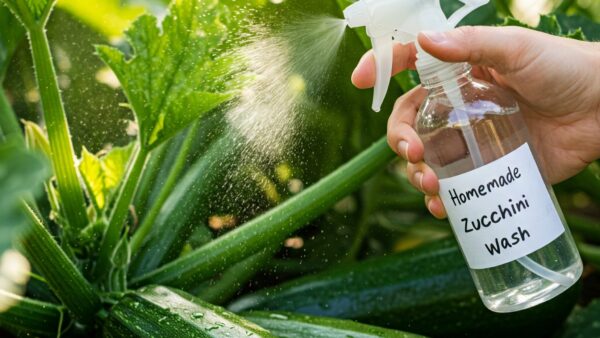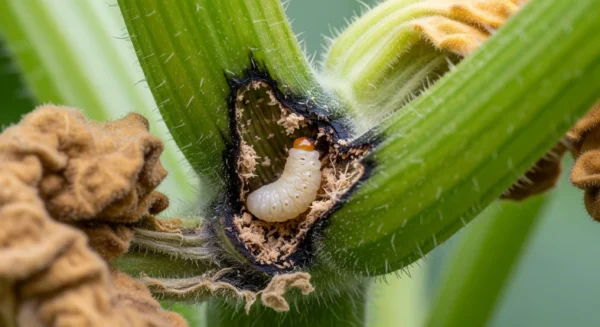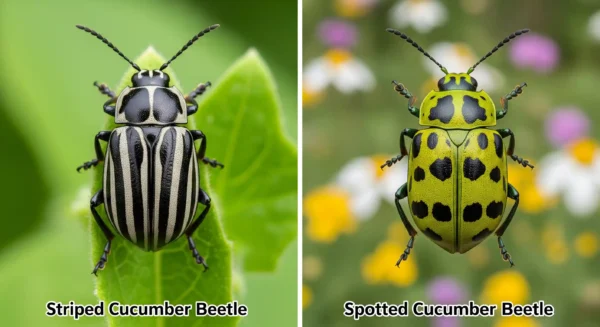Try not to panic. What Do Those White Spots on Your Zucchini Leaves Really Mean?
You have done exactly what is needed. From small seeds, you tenderly cared for your zucchini, watered them assiduously, and proudly watched as those large, lovely leaves unfolded. Already your dreams are of grilled zucchini, zucchini bread, and zoodles galore. You then see it one sunny afternoon. On a leaf, a few barely perceptible, white, dusty patches. You gaze closer. Someone apparently stopped by and lightly dusted your plant with flour.
I too know that sinking sensation in the gut pit. Is some unknown zucchini plant issue likely to destroy all of your effort?
inhaled deeply. I am here to reassure you it will be fine. You can definitely control powdery mildew, which is most likely what you are witnessing and one of the most frequent problems zucchini farmers all around face. You are not the first gardener to encounter this white enemy, and most probably not the last.
Consider me as your garden buddy who has gone through this a thousand times. We will have your plants back on schedule together. I will first assist you to precisely pinpoint what is happening. I will then walk you through precisely how to treat it using straightforward, powerful techniques. Above all, we will discuss how to stop it from returning so you may concentrate on what truly counts: a plentiful crop. Set ready? Let we begin.
Powdery Mildew is what? Determining the White Foe
We must be absolutely sure we know what we are up against before we can counter. A powdery mildew looks quite different. First you will notice those tell-tale circular white dots on the top surface of the leaves and on the leaf stems. They really seem to be little talcum powder splotches or as though they had been just gently sprinkled with flour. Should you let it go, these discrete areas will expand and combine to finally cover the whole leaf in a white, dusty coat. Severe cases even show it on the zucchini fruit itself.
The infected leaves will become yellow, dry and brittle over time, and may finally die altogether. Those large green leaves are your plant’s solar panels, so you could be wondering, “So what’s the big deal if a few leaves get crusty?” Acting as a thick blanket, the powdery mildew blocks sunlight and stops leaf photosynthesis. This basically saps the plant of energy, which results in less development, a lower harvest, and occasionally even influences the flavor and size of the zucchini you do receive.
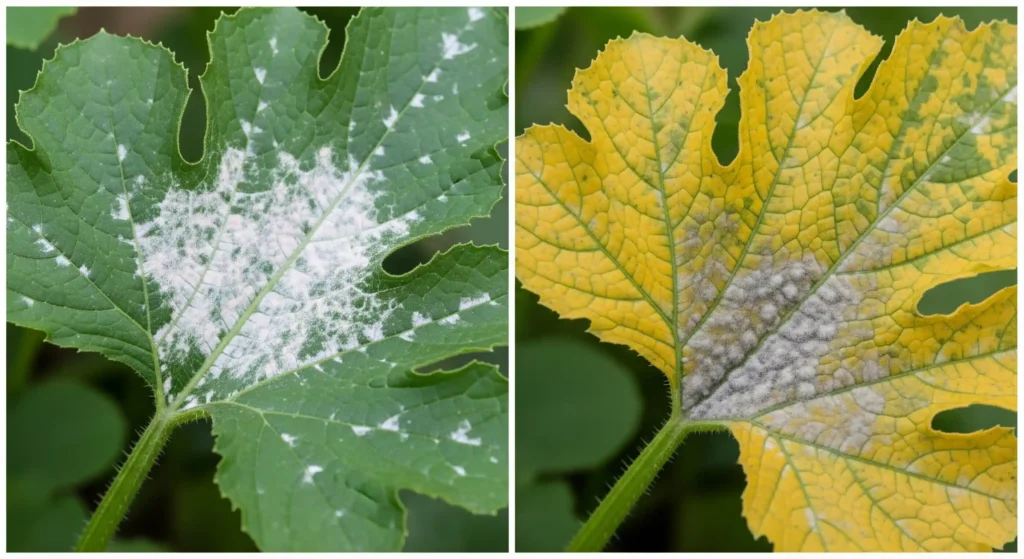
Here now is a very important pro-tip. Sometimes mistaken with its powdery relative, another illness is downy mildew. But one can tell them different quite easily. As we have indicated, powdery mildew resembles a powder placed on top of the leaves. Conversely, downy mildew usually appears as yellow dots on the surface of the leaf with a fuzzy, grayish mold developing on the underside. Any gardener’s first important diagnostic action is flipping a leaf over. This difference is important as the therapies can differ. For our purposes, you are in the correct place—you are dealing with powdery mildew—if the white stuff is on top.
The Perfect Storm: Why Your First-Place Zucchini Got Powdery Mildew
The frustrating reality is that powdery mildew spores are almost everywhere—in the air, in the soil, just waiting for their chance to shine. You might be asking, “Where did this even come from?” See them as little weed seeds, just floating about searching for the ideal place to land and set up camp. Your garden did not get it as you done something “wrong”; it got it when the environment became exactly ideal for the fungus to flourish.
What then defines this “perfect storm”?
- Perfect weather for powdery mildew is warm days and cool, humid evenings. Following chilly, moist evenings that let liquid rest on the leaves without evaporating, the fungus enjoys those scorching, dry daytime temperatures we often have in mid-to-late summer. It is the formula for a mildew explosion.
- The one most important is poor air circulation. Zucchini plants develop into spreading, thick bushes with large leaves. Plants too close together or surrounded by weeds prevent free air movement among their foliage. This retains humidity around the leaves, producing a five-star resort for fungal development—a stationary, wet microenvironment. Of all the elements, the one most effective preventive action you can do is increase air circulation.
- Too Much Shade: Although zucchini may withstand some shade, they really require a lot of direct sun. Shorter-growing plants are more vulnerable since the leaves remain moist for far longer following a rain shower or a misty night, allowing the spores of time to germinate and infect the leaf.
- Though we all want to feed our plants the best nourishment, occasionally we could be overly generous. Overly high nitrogen fertilizers might lead the plant to generate a lot of soft, luxuriant, green foliage. Unlike older, tougher leaves, this new growth is quite delicate and far more sensitive to a powdery mildew infection.
Shifting from just addressing the problem to actively preventing it depends on an awareness of these elements. You’re reclaiming control by making your garden less friendly to the fungus.
First Aid for Your Zucchini: Rapid Treatment Approaches
Alright, now that we have the enemy and its fighting strategy known, It is now time to retaliate. If you have an active powdery mildew infection, you must act quickly to stop it cold. This is your detailed walk-through manual for first aid for plants.
Your First Move: Cut and discard.
Get a pair of clean pruning shears or scissors before you start considering spraying anything. Snip off the leaves most covered in white very deliberately. This lowers the total fungal load on your plant, thus immediately benefits you. Try not to shake the leaves too much; this can spew a cloud of spores onto good vegetation. Be gentle. And here comes a crucial step: avoid throwing these sick leaves into your compost heap. From your compost, the spores live and proliferate. To permanently leave your garden free, toss them straight into a yard waste bag or the garbage.
Organic and Do-it-yourself fixes from your kitchen
For many gardeners, their first line of protection is searching for a homemade cure. Particularly if you discover the infection early, these cheap, easily available choices can surprisingly be quite effective.
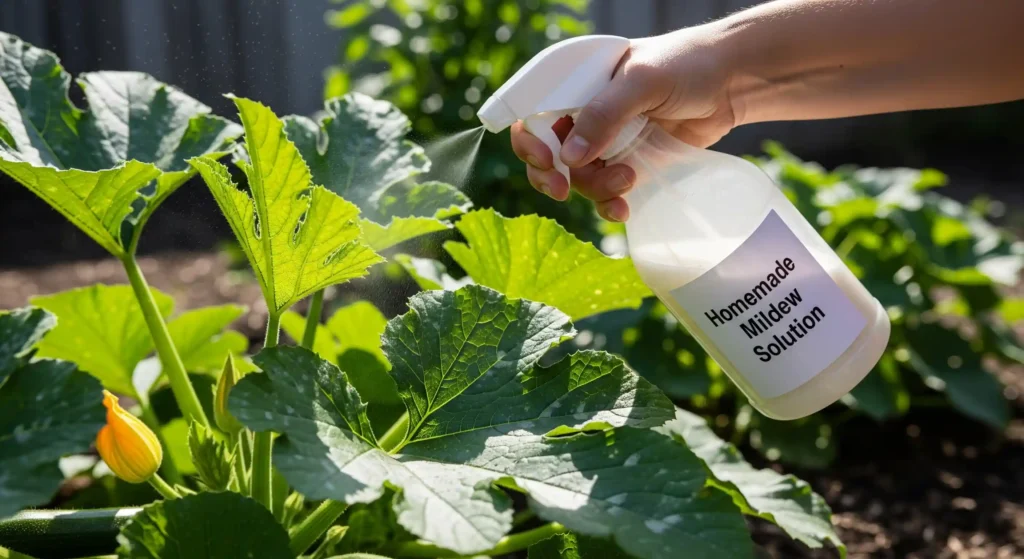
- Though it seems like an old wives’ story, this is a real and well-liked organic remedy. The idea is that milk’s whey proteins produce an antiseptic action on the fungus when subjected to direct sunlight. In a spray bottle, simply toss a 40% milk (any sort) solution with 60% water.
- Baking soda works by altering the pH on the surface of the leaf, therefore producing an alkaline environment in which the fungus spores cannot thrive. For good reason, this is a classic. Into one gallon of water, mix one tablespoon of baking soda and one half teaspoon of a light liquid soap (such as Castile soap, which helps the solution attach to the leaves).
- Within the toolset of an organic gardener, neem oil is a powerhouse. Acting both as a preventive and a fungicide, neem oil derived from the seeds of the neem tree kills current mildew. One great plus is that it can also assist with other pests. Just be sure you get cold-pressed, 100% pure neem oil. Following package guidelines, you will combine it with water and a bit soap. Use neem oil early in the morning or evening; never apply it under strong daytime sunlight since it can burn the foliage.
Commercial Chemicals for More Difficult Problems
It could be time to call in a commercial fungicide if you are dealing with a highly persistent or extensive illness or if the do-it-yourself techniques are not working. Not to worry; yet approved for organic gardening are several sensible choices. Look for items in the garden center that mention potassium bicarbonate, sulfur, or a copper-based fungicide as the active ingredient. Particularly useful is potassium bicarbonate, which acts quite fast and is basically a more powerful variation of the baking soda cure. Please carefully read and follow the label directions as with any good. The instructions guarantee your safety and help to guarantee the product performs as expected.
The Golden Rule of Implementation
The process is the same regardless of the spray you decide for. To be sure your spray won’t damage the plant, first always try it on one or two leaves and wait 24 hours. When you’re ready for a complete application, thoroughly spray your plants, paying close attention to both the tops and—just as importantly—the undersides of the leaves. Also coat the stems. You aim to set up a situation whereby no spore, anywhere it hides, cannot survive.
The best medicine is prevention; how might one stop powdery mildew before it starts?
Although knowing how to treat powdery mildew is fantastic, wouldn’t it be even better if you never had to deal with it at all? The ultimate gardening power action is changing your perspective from reactive to proactive. You save a lot of time and anxiety by setting up an atmosphere where this fungus just cannot find a footing. Here are the secrets to a zucchini patch free of mildew.
- Give your plants some breathing room; I see this constantly. In the spring, we get so enthusiastic that we plant our tiny zucchini seedlings far too closely together. Those little plants, however, soon grow to into huge, spreading shrubs. From day one, make sure there is appropriate distance; review the seed packet for ideas. This promotes excellent air circulation, the enemy of powdery mildew. One of the finest defenses you have is a little breeze running across your plants.
- Zucchini are sun enthusiasts. Let the Sun Shine In. To really flourish, they need at least six to eight hours of direct, strong sunlight every day. A sun-drenched area robs mildew spores of the moisture they require to develop, therefore helping leaves dry out fast from morning dew or a summer shower.
- Simple tweak that makes a big impact: water the soil, not the plant. Make a deliberate attempt to pour water straight to the base of the plant when watering your yard, therefore soaking the soil rather than the leaves. Particularly overnight, wet leaves invite fungal illnesses rather openly. For this, a soaker hose or drip irrigation system is great; but, even just cautious water use has amazing results. And try watering in the morning so the sun has all day to evaporate any inadvertent spills.
- Prune for Airflow: Cut back on your zucchini plant’s hair. The bottom leaves might get gigantic as it develops, obscuring the plant’s center and catching dampness. Pruning some of these big, lower leaves selectively—especially ones that touch the ground—opens the plant and greatly increases air flow. It reminds me somewhat of opening a window in a stifling room.
- Maintaining good garden hygiene is far more crucial than you would believe. Clear all of the dead zucchini plant trash at the end of the growing season. Just ready to reinfect your garden next year, those annoying spores can really survive the winter on old leaves and stems.
- Think about a preventive spray if you live in an area where powdery mildew is a yearly battle that never stops. Especially when the humid days of mid-summer approach approach, a small application of neem oil or your chosen preventative fungicide every 10 to 14 days will help to stop an infection before you ever see a single white spot.
Select Your Allies: Varieties of Powdery Mildew Resistant Zucchini
If you feel as though you are constantly battling powdery mildew year after year, I want to let you in on a game-changing secret: you can let the plants fight some of the battle for you. For years, plant breeders have labored to create amazing zucchini types with inherent, natural resistance to powdery mildew.
Now, it’s crucial to realize that “resistant” does not equal “immune.” A resistant variety can still have a few patches of mildew, especially late in the season or during a very terrible year. The distinction is really dramatic, though. They fight the virus for far longer, and it hardly gets strong enough to affect the state of the plant or your yield. For many gardeners, changing to one of these kinds transforms a continual headache into a slight annoyance during late-season.
Look for labels on seeds or starting plants that read “PMR” (Powdery Mildew Resistant) or clearly indicate a strong disease resistance. Among the excellent and extensively available kinds to search for are:
- PM succeeding success
- Destination
- Golden Glory
- Tress
- Rural
The best proactive approach is to select a resistant variety; it will equip you for success before you ever sow the first seed.
Finally, savor your wonderful, nutritious zucchini crop.
Though it can be demoralizing to have a plant disease like powdery mildew, I hope you now feel confident and capable to manage it. Recall the basic plan: Vigilance plus good airflow plus proper watering. Keeping a close check on your plants and designing a garden that discourages the fungus can help you to identify any problems before they become unmanageable.
Simply a part of the great experience that is gardening, powdery mildew is not a sign of failure. With the correct information, you now know just how to solve this riddle. So go forth, apply these ideas, and be ready to savor all the wonderful, nutritious zucchini you can consume. You have earned it.
Often asked questions
Can one eat zucchini with powdery mildew safely?
Yes, exactly! Though the plant’s leaves have powdery mildew on them, the zucchini fruit itself is quite safe to eat. As you would typically, just give the zucchini a decent wash. Should the infection cause extreme stress to the plant, the fruit’s quality or size may be somewhat reduced, but it poses no risk to you in any other sense.
Can I just clean the leaves of powdery mildew?
Although you might physically clean the white fungus off a leaf, this is only a temporary cosmetic remedy. The fungus grows back quite rapidly without appropriate treatment spray since its microscopic structures have already reached the surface of the leaf. Moreover, wiping can unintentionally aggravate the situation by readily distributing the invisible spores to healthy areas of the plant.
Will my other plants get the powdery mildew from my zucchini?
The response to that is both yes and no; it’s a wonderful question. Actually, powdery mildew is a really picky eater; most forms are species-specific. This means your roses, tomatoes, or lilacs won’t be infected by the specific strain of powdery mildew that affliches your zucchini and other squash-family plants (such as cucumbers, pumpkins, and melons). But if the surroundings fit the zucchini mildew, they also fit other kinds of powdery mildew. Therefore, even if the disease won’t leap from your zucchini to your roses, you may find a totally other powdery mildew infection on your roses concurrently.





